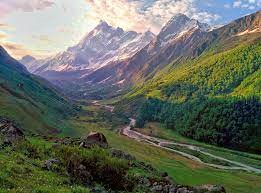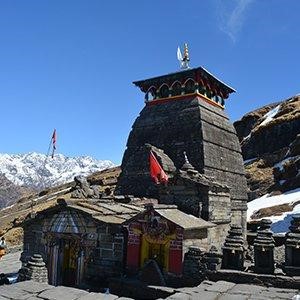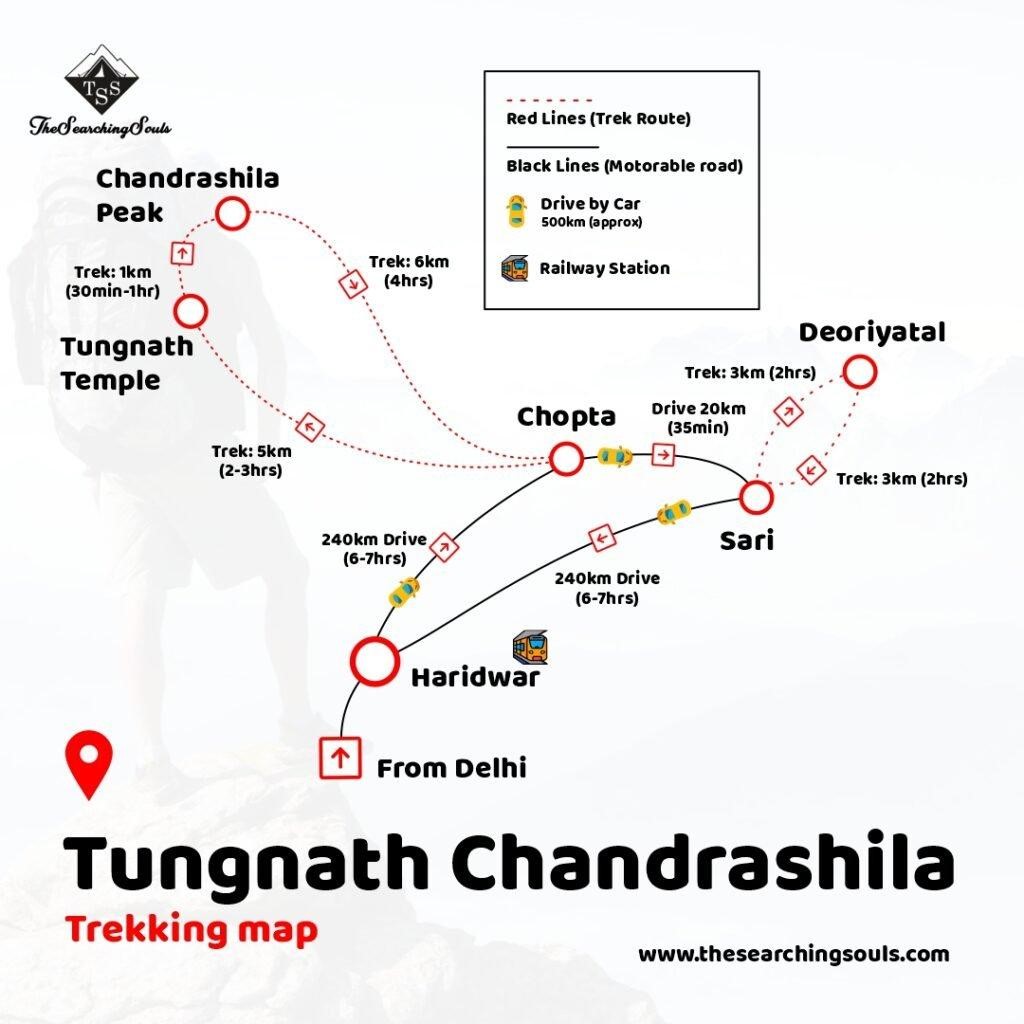Embark on a Himalayan adventure with the Har Ki Dun and Tungnath Chandrashila Trek. Explore breathtaking landscapes and ancient temples. Book Your Trek now!
Introduction
For many adventure seekers, traveling into the heart of the Himalayas is their dream. The Har Ki Dun and Tungnath Chandrashila Trek offer an unparalleled experience, combining breathtaking landscapes, spiritual encounters, and physical challenges. In this article, we’ll delve into the details of these treks, guiding you through the majestic terrains and cultural richness of the Himalayas.
The Har Ki Dun Trek

Historical Background
The Har Ki Dun trek, nestled in the Garhwal region, has a rich historical background. It was traversed by the Pandavas in the Mahabharata, adding a mythological aura to the trail. Today, trekkers follow in the footsteps of legends, exploring the picturesque valley surrounded by snow-capped peaks.
Route Details

The trek begins from Sankri, winding through dense pine forests and quaint villages. Trekkers traverse Osla, with its ancient temples, and continue to Har Ki Dun, a valley renowned for its stunning beauty. The trail offers glimpses of Swargarohini, Bandarpoonch, and Black Peak, creating a mesmerizing backdrop.
Choose The Searching Souls for your Har Ki Dun adventure, where every moment is curated to provide not just a trek but a soul-stirring connection with nature and local communities.
Flora and Fauna
The Har Ki Dun trail is a paradise for nature enthusiasts. Alpine meadows adorned with vibrant wildflowers, dense forests housing diverse wildlife, and the melody of flowing rivers create an immersive experience. The trek provides a unique opportunity to witness the biodiversity of the Himalayas.
Tungnath Chandrashila Trek

Overview of the Trek

A spiritual and daring journey is the Tungnath Chandrashila Trek. It begins at Chopta, known as the ‘Mini Switzerland of India,’ and leads to the highest Shiva temple, Tungnath. A climb to Chandrashila Peak, which provides sweeping views of the Himalayan range, marks the journey’s climax.
Sacred Tungnath Temple
Tungnath, at an altitude of 12,073 feet, is not only the highest Shiva temple but also one of the Panch Kedar temples. Pilgrims and trekkers alike are drawn to the spiritual aura of this ancient shrine. The trek to Tungnath is a divine experience, filled with reverence and awe.
Summiting Chandrashila Peak

Chandrashila, translating to ‘Moon Rock,’ is the pinnacle of the trek. At an altitude of 13,123 feet, it provides a 360-degree view of Nanda Devi, Trishul, and Chaukhamba peaks. The sunrise from Chandrashila is a spectacle that etches itself into the memory of every trekker.
Let The Searching Souls be your guide to the ethereal landscapes of the Tungnath Chandrashila Trek, where the trails lead to not just breathtaking views but to a spiritual awakening.
Preparing for the Odyssey
Physical Fitness
In order to trek in the Himalayas, one must be physically fit. Pre-trek workouts focusing on endurance and strength are essential. Cardiovascular exercises and strength training prepare the body for the challenges of high-altitude trekking.
Essential Gear
The right gear can make or break a trek. Quality trekking boots, layered clothing, a sturdy backpack, and essential accessories like trekking poles are crucial. Carrying a well-equipped medical kit is equally important to handle any unforeseen situations.
Weather Conditions
The weather in the Himalayas is erratic. Trekkers should be prepared for sudden changes in temperature, rain, and snow. Checking the weather forecast, carrying waterproof gear, and layering appropriately can ensure a comfortable trekking experience.
Experiencing the Himalayan Landscape
Majestic Mountain Views
The Har Ki Dun and Tungnath Chandrashila treks offer postcard-perfect views at every turn. Trekkers are treated to the sight of snow-capped peaks, glaciers, and pristine landscapes. Each step brings a new panorama, creating a visual feast for nature lovers.
Unique Flora and Fauna
The biodiversity along these trails is astounding. From Himalayan monals and musk deer to the elusive snow leopard, the region supports a variety of wildlife. Trekkers often spot Himalayan flowers like the Brahma Kamal, adding color to the green meadows.
Cultural Interactions with Local Communities
The Himalayan villages along the trek route provide a glimpse into the unique culture of the region. Interacting with locals, tasting traditional cuisine, and experiencing their hospitality adds a cultural dimension to the trek. Trekkers often find warmth in the simple yet profound mountain way of life.
Challenges on the Trails
Altitude Sickness Precautions
Hiking at high altitudes requires acclimatization. Trekkers should ascend gradually, stay hydrated, and be aware of symptoms of altitude sickness. Carrying medications like acetazolamide can be a preventive measure.
Weather Challenges
The Himalayan weather can be unpredictable, with conditions changing rapidly. Trekkers should be prepared for rain, snow, and cold temperatures. Flexibility in the itinerary to account for weather changes ensures a safe and enjoyable trek.
Terrain Difficulties
The trails present diverse terrains, from rocky paths to snow-covered slopes. Trekking poles provide stability, especially while descending. Proper footwear and cautious navigation are essential to navigate the challenging terrain.
Capturing Memories
Photography Tips
The landscapes of the Har Ki Dun and Tungnath Chandrashila treks are a photographer’s delight. Capturing the essence of the journey requires a good camera and an eye for detail. Early mornings and late evenings offer the best lighting for memorable shots.
Must-Visit Spots for Breathtaking Views
Certain spots along the trek route offer unparalleled views. From the Har Ki Dun valley to the summit of Chandrashila, these locations provide trekkers with moments of awe and inspiration. Taking the time to soak in these views is an integral part of the trekking experience.
Immersive Storytelling
Beyond photographs, the journey is enriched by storytelling. Documenting personal experiences, encounters with locals, and the challenges overcome creates a narrative that goes beyond visuals. Sharing these stories with fellow trekkers and friends adds a personal touch to the adventure.
The Spiritual Connection
Tungnath Temple’s Spiritual Significance
Tungnath, believed to be more than 1,000 years old, holds immense religious importance. The serene environment surrounding the temple invites moments of introspection and spiritual connection. The chanting of prayers and the aroma of incense create a peaceful atmosphere.
Meditative Moments on the Trails
The solitude of the Himalayan trails provides an opportunity for introspection and meditation. Trekking becomes a meditative practice, allowing individuals to connect with nature, silence the mind, and experience a profound sense of peace.
Connecting with Nature
The trek fosters a deep connection with the natural world. From the rustling of leaves in the wind to the gushing sound of mountain streams, trekkers become attuned to the rhythms of nature. This connection is a transformative aspect of the Himalayan experience.
Sustainability Practices
Leave No Trace Principles
Preserving the pristine beauty of the Himalayas is paramount. Trekkers are urged to minimize their environmental impact by adhering to the “Leave No Trace” philosophy. Proper waste disposal, avoiding unnecessary noise, and respecting wildlife habitats contribute to sustainable trekking.
Encouraging Regional Communities
The trekking industry is a significant source of livelihood for local communities. Supporting local businesses, homestays, and buying handmade crafts contribute to the economic well-being of the region. Responsible tourism ensures a positive impact on both the environment and local residents.
Conscientious Hiking Methods
Responsible trekking involves respecting the natural and cultural heritage of the region. Staying on designated trails, avoiding the collection of flora and fauna, and adhering to ethical practices contribute to the long-term sustainability of Himalayan trekking.
Testimonials and Personal Stories
Real-Life Experiences
Trekkers often return with tales of triumph, camaraderie, and self-discovery. Real-life experiences highlight the diverse aspects of the trek, from conquering challenging terrains to forging lasting friendships. These stories inspire others to embark on their own Himalayan odyssey.
Impact on Individuals
The impact of the Har Ki Dun and Tungnath Chandrashila trek goes beyond the physical. Many trekkers find a sense of accomplishment, improved mental resilience, and a rekindled connection with nature. The transformative power of the trek leaves a lasting imprint on individuals.
Inspiring Narratives
Inspiring narratives from trekkers who overcame personal challenges or discovered new facets of themselves on the trails motivate others to embark on similar journeys. These narratives contribute to the sense of community among Himalayan trekkers.
The Rewards of the Journey
Personal Growth and Self-Discovery
The challenges of the Har Ki Dun and Tungnath Chandrashila trek push individuals beyond their comfort zones. The voyage turns into a metaphor for life, encouraging introspection, resiliency, and personal development. Trekkers often find themselves stronger and more self-aware after completing the expedition.
Accomplishments and Achievements
Reaching the summit of Chandrashila or completing the Har Ki Dun trek is a remarkable accomplishment. The sense of achievement and the breathtaking views from the highest points are rewards that trekkers carry with them long after the journey concludes.
The Lasting Impact on Trekkers
The Himalayan odyssey leaves an indelible mark on trekkers. The memories, lessons learned, and the beauty witnessed during the expedition become a part of their identity. The lasting impact transcends the physical journey, influencing trekkers in various aspects of their lives.
Conclusion
In conclusion, the Har Ki Dun and Tungnath Chandrashila trek offer a transformative experience that combines adventure, spirituality, and a deep connection with nature. These treks go beyond being physical challenges; they become journeys of the soul, leaving trekkers with a sense of accomplishment and a profound connection with the Himalayas.
Frequently Asked Questions
Is prior trekking experience necessary for the Har Ki Dun and Tungnath Chandrashila trek?
While prior trekking experience is beneficial, these treks are suitable for beginners with a good level of fitness. Proper preparation is key.
When is the ideal time to go on these hikes?
The optimal trekking season is from April to June and September to November. Avoid the monsoon season for a safe and enjoyable experience.
Exist lodging options along the paths of the treks?
Yes, there are trekking camps and guesthouses in villages along the routes. Trekkers can also opt for homestays for a more authentic experience.
How can I contribute to sustainable trekking practices?
Follow “Leave No Trace” principles, support local businesses, and choose eco-friendly trekking agencies to minimize your environmental impact.
What level of physical fitness is required for these treks?
Trekkers should have a good level of cardiovascular fitness and strength. Pre-trek exercises and acclimatization are essential.
